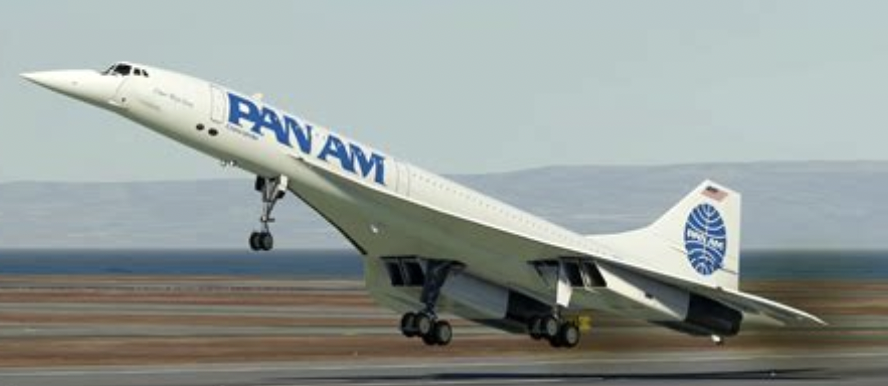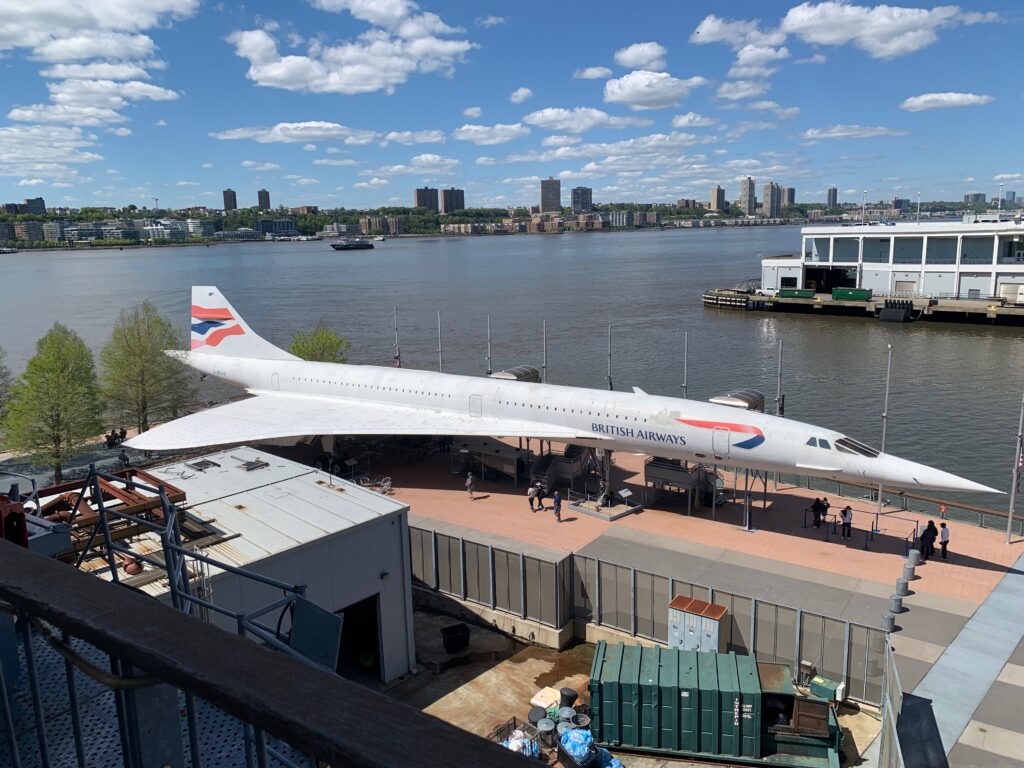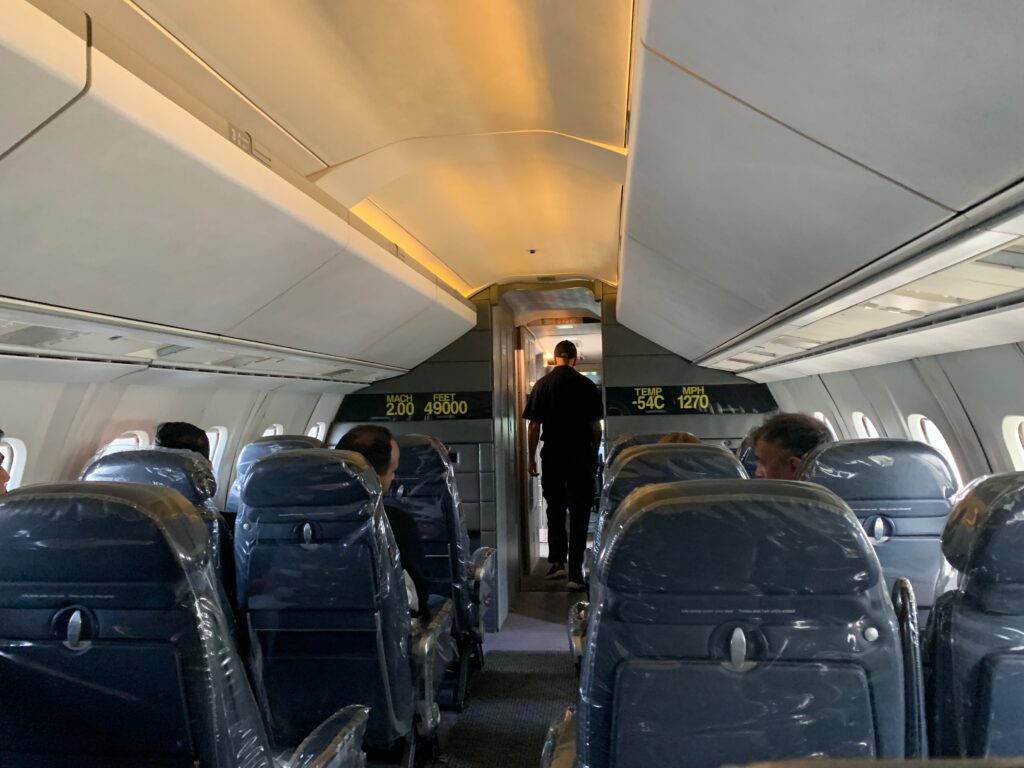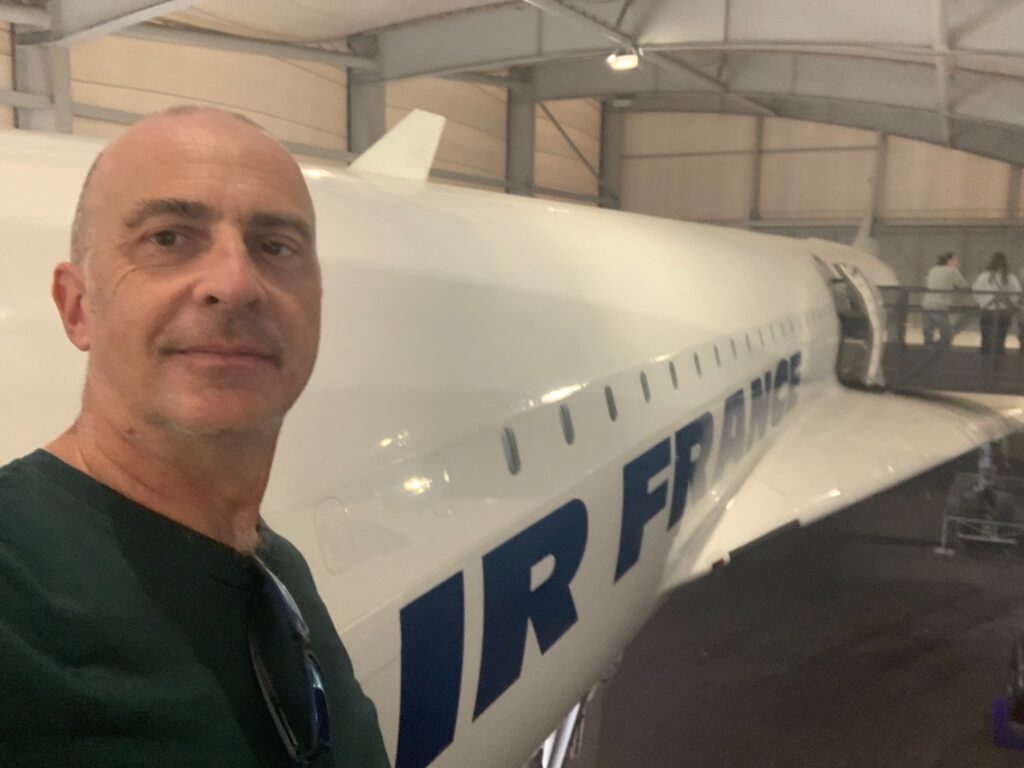The majestic, sleek Concorde has always captured my attention with its breathtaking beauty and speed. I only ever dreamed of flying on it, but I’ve made up for that by visiting almost every Concorde still in existence!
Just 20 Concorde aeroplanes were ever built. Two were prototypes, two were pre-production aircraft, two were development aircraft, and the remaining 14 were built for commercial service. These 14 aircraft were operated solely by Air France and British Airways (then known as BOAC, British Overseas Aircraft Corporation).

Airlines such as Iran Air, Japan Airlines, Pan Am, and Qantas, expressed interest in Concorde. However, skyrocketing oil prices, the long timelines, and competition from more affordable planes like the 747 meant they cancelled their orders.
Singapore Airlines and Braniff did briefly operate Concorde through arrangements with British Airways and Air France.
The Concorde program eventually cost around £12 billion in today’s money. Its legacy lives on, influencing the design of almost every modern aircraft.
The first test Concorde took to the skies on 2 March 1969 (registration F-WTSS) from Toulouse, France. The second prototype followed on 9 April 1969 (registration G-BSST) from Filton, England.
Concorde commenced commercial service on January 21, 1976. On this date, British Airways operated its inaugural flight from London Heathrow to Bahrain, while Air France flew from Paris Charles de Gaulle to Rio de Janeiro via Dakar.
The fleet flew regularly from London and Paris to New York and DC for decades until 25 July 2000, when Air France Flight 4590 (registration F-BTSC) crashed in a fiery blaze at Gonesse, France, killing all 100 passengers, nine crew members, and four people on the ground. After a long grounding and safety modifications, Concorde resumed commercial operations on 7 November 2001, but its retirement soon followed in 2003. The last Concorde flight took place exactly 21 years ago on 26 November 2003, when it landed at Bristol Filton Airport for display at the museum there.
Today, you’ll find all but two Concordes preserved worldwide. Air France scrapped one in 1994, and the other is the Concorde, which was destroyed in the 2000 crash.
| Aircraft Number | Registration | Date First Flew | Current Location | Additional Information |
|---|---|---|---|---|
| 001 | F-WTSS | 2 March 1969 | Musée de l’Air et de l’Espace, Le Bourget, France | The very first-ever Concorde. to fly |
| 002 | G-BSST | 9 April 1969 | Fleet Air Arm Museum, Yeovilton, England | Prototype aircraft – second to fly |
| 101 | F-WTSA | 10 January 1973 | Musée Delta, Athis-Mons, France | Pre-production aircraft |
| 102 | G-AXDN | 17 December 1971 | Imperial War Museum, Duxford, England | Pre-production aircraft |
| 201 | F-WTSB | 6 December 1973 | Airbus Factory, Toulouse, France | First production aircraft, used for testing |
| 202 | G-BBDG | 13 February 1974 | Brooklands Museum, Weybridge, England | First production aircraft, used for testing |
| 203 | F-BTSC | 31 January 1975 | —- | Fuselage remains stored in a hangar. Memorial garden near Charles de Gaulle Airport |
| 204 | G-BOAC | 27 February 1975 | Manchester Airport, England | First British Airways Concorde for commercial service |
| 205 | F-BVFA | 27 October 1975 | Smithsonian Museum Udvar-Hazy Center, Chantilly, Virginia, U.S. | First Air France Concorde to serve Rio de Janeiro, Washington, D.C., and New York. Flown 17,824 hours. |
| 206 | G-BOAA | 5 November 1975 | National Museum of Flight, East Fortune, Scotland | First British Airways Concorde in commercial service |
| 207 | F-BVFB | 6 November 1975 | Technik Museum Sinsheim, Germany | |
| 208 | G-BOAB | 18 May 1976 | Heathrow Airport, England | |
| 209 | F-BVFC | 3 August 1976 | Aeroscopia, Toulouse, France | |
| 210 | G-BOAD | 25 August 1976 | Intrepid Museum, New York City, U.S. | |
| 212 | G-BOAE | 13 August 1977 | Grantley Adams Airport, Barbados | |
| 213 | F-BTSD | 26 June 1978 | Musée de l’Air et de l’Espace, Le Bourget, France | The Pepsi Plane! |
| 214 | G-BOAG | 21 April 1978 | Museum of Flight, Seattle, Washington, U.S. | Flew the last BA commercial Concorde flight from New York to London on October 24, 2003. |
| 215 | F-BVFF | 26 December 1978 | Charles de Gaulle Airport, France | |
| 216 | G-BOAF | 20 April 1979 | Aerospace Bristol, Filton, England | Final Concorde built |
I’ve organised the Concordes by location—Barbados, France, Germany the UK, the USA, to make it easier for others to plan visits, while also including details like model numbers and first flight dates for aviation enthusiasts.
Barbados
Location: Grantley Adams Airport
Model: British Airways G-BOAE, “Alpha Echo” Prodn No: 215, Manufacturer’s Serial Number 100-010
Flew: From March 17th, 1977 to November 17th, 2003
By Road: Grantley Adams International Airport, Seawell, Christ Church, Barbados. It’s accessible via Highway 7 (ABC Highway). From Bridgetown, Barbados’s capital city, take Highway 7 towards the east and follow signs to the airport.
Transit: The Transport board runs a bus to the airport every 20 minutes.
Alpha Echo landed in Barbados, was originally set up as Barbados Concorde Experience. In 2023, the Barbados Government announced that the Concorde hangar was being converted into a new departure terminal. The Concorde is now offlimit for visits.
United States
New York, New York

Location: Intrepid Museum, Entry fee required plus extra to tour Concorde. Booking ahead for the tours is vital as many people were disappointed to find they sell out .
Model: British Airways G-BOAD, “Alpha Delta” Prodn No: 210, Serial Number 210-024
Flew: From November 25, 1975 to November 10, 2003
Address: Intrepid Sea, Air & Space Museum, Pier 86, W 46th St & 12th Ave, New York, NY 10036 accessible via I-495 and FDR Drive
Transit: 50th Street (C, E Subway Lines)
Earlier theyear Intrepid Museum’s British Airways Concorde departed and returned by barge for a months-long restoration project at the Brooklyn Navy Yard.

I took a tour of the Concorde last year before its renovation. Its exterior looked a little sad, so I am thrilled at its cleaning up.
Washington, D.C. F-BVFA
Location: Smithsonian Museum’s Steven F. Udvar-Hazy Center, Free Entry
Model: Air France Concorde “F-BVFA” (Foxtrot Alpha), Prodn No: 205, Serial Number 205-014
Flew: October 25, 1976, to June 12, 2003.
Address: Steven F. Udvar-Hazy Center, 14390 Air and Space Museum Parkway, Chantilly, VA 20151
By Road: The museum is accessible via Interstate 66 and Route 28. From Interstate 66, take Exit 53B and follow signs to the museum.
Transit: Metro Silver Line to Innovation Center station. Transfer to Fairfax Connector Bus No. 983.
In 1989, Air France donated a Concorde to the Museum upon the completion of its last flight. Concorde is displayed in Business Aviation at the Steven F. Udvar-Hazy Center in Chantilly, Virginia, along with Space Shuttle Discovery. In addition to Concorde, The Smithsonian also features the Wright brothers’ Flyer, Amelia Earhart’s Lockheed Vega, the Apollo 11 command module plus significant items from the Space Shuttle program.
Seattle, Washington G-BOAG
Location: Museum of Flight, Entry Fee required (FREE on First Thursday of the month). You can also tour this model virtually.
Model: British Airways G-BOAG, “Alpha Golf” Prodn No: 214, Manufacturer’s Serial Number 214-011
Flew: From April 21, 1978 to November 10, 2003. Logged more than 5,600 takeoffs and over 16,200 flight hours
Address: Museum of Flight, 9404 E Marginal Way S, Seattle, WA 98108
By Road: The museum is located near Interstate 5 and accessible via the Boeing Access Road. From Interstate 5, take Exit 158 onto Boeing Access Road and follow signs to the museum.
Transit: METRO Bus #124 from Downtown Seattle or Tukwila Station to the bus stop directly in front of the Museum.
Alpha Golf is the first Concorde that I ever visited. On its retirement flight to The Museum of Flight on November 5, 2003, Alpha Golf set a NYC-to-Seattle speed record of 3 hours, 55 minutes, and 2 seconds. O, that flight, it flew supersonic for 1 hour, 34 minutes, and 4 seconds over northern Canada.
The Seattle Museum of Flight is home to several other historic aircraft, including Air Force One, the first Boeing 747, the first Boeing 787 Dreamliner, and an original Boeing 727. For a nerd, its one of the best museums!
France
Northern Paris
Location: Charles de Gaulle Airport, France
Model: F-BVFF (Early arrival) – Prodn No: 215,
Flew: October 27th, 1975 to June 11th, 2000
Location: Musée de l’air et de l’espace/ Museum of Air & Space Paris, Le Bourget, Entry fee + it has been traditionally included in the Paris Musee Pass.
This is one of the locations hwree there are two Concordes on display, and one can explore the interiors of both for no extra cost.
Model: Aérospatiale/BAC “F-WTSS” Concorde 001 (French Prototype) Prodn No: 001, Serial No: 100-001, First flew on March 2, 1969, and its last flight was on May 19, 1976.- 397 flights
Model: Air France “F-BTSD” Prodn No: 213, Serial No: 213 Flew from June 26, 1978 to June 11, 2000
Address: Aéroport de Paris-Le Bourget, 93350 Le Bourget, France
By Road: The museum is situated near the A1 motorway (Autoroute du Nord) and can be accessed via local roads. From central Paris, take the A1 motorway towards Lille and exit at Le Bourget.
Transit: Visitors can use public transportation to reach Le Bourget station and then proceed by walking or taking a short taxi ride to the museum.

F-WTSS is igsinficnat because it was . She wulkd fly . This models introduced the delta wings and the advanced aerodynamics that would enable supersonic flight. Concorde 001, the first prototype, rolled out of the factory on December 11, 1967. After fifteen months of ground testing, she took off from Toulouse on March 2, 1969. The 001 reached Mach 1 on October 1, 1969, and Mach 2 on November 4, 1970. She retired to this museum back in 1973, after chasing the 1973 solar eclipse. For the eclipse flight, portholes were added and viewing gear put on the roof. The museum display celebrates this achievement and F-WTSS has the markings from that Solar Eclipse mission and the portholes on the roof.
Air France F-BTSD was painted in a special Pepsi livery in 1996, as part of a marketing campaign for the soft drink. The aircraft continued to operate in commercial service with this special livery for a period before its retirement. Sadly the plane is back in its original Air France colours. I would have loved to see the Pepsi colours! It is, however, one of the best-preserved Concorde aircraft in teh world. Some of its systems are still in working condition, and all four Olympus engines are fitted.

Southern Paris
Location: Musée Delta, Paris, Athis-Mons, only open Wed and Sat, Small entry charge
Model: Aerospatilae F-WTSA French Pre-production model Prodn No: 102
Flew: February 23rd 1973 to May 26, 1976
Address: Musée Delta, Rue du Bac, 91200 Athis-Mons, France
By Road: The museum is accessible via the A6 motorway. From central Paris, take the A6 motorway towards Lyon and exit at Athis-Mons.
Transit: Tramway T7 to the end of the line and the Musuem is a short walk. The trams actually pass the Concorde which is an awesome sight.
I had a terrific visit here. This museum is actually dedicated to he delta wing and one of its inventors, Nicolas Roland Payen. This wing design of course ended up on the Cncirde. The very enbthisatsic volunteers took a lot of time to show off their aircraft. Sierra-Alpha was the first to have the dimensions and shape of the actual production aircraft. For several years during testing the aircraft was painted in British Airways colours on one side and Air France’s 1970’s livery on the other, although she was still registered as a French aircraft. This is how she appears now.
F-WTSA played a significant role in validating the Concorde design’s aerodynamic characteristics, performance capabilities, and handling qualities. She contributed valuable data and insights that informed subsequent modifications and refinements to the production models. Sierra-Alpha was the very first Concorde to visit the United States, landing in Dallas, in September 1973. On her return trip from Washington DC to Orly she became the first Concorde to carry passengers across the Atlantic with 32 passengers onboard.
Toulouse
There are two Cncirdes in Toulise
Location: Aeroscopia Museum: Airbus Factory, Toulouse, France, entry fee
Model: Aerospatiale F-WTSB, Prodn No: 201, Flew: 6th December 1973 to May 26th, 1976
Model: Air France F-BVFC, Prodn No: 209, Flew: 9th July 1976 to June 27th 2003
Address: Rue Roger Béteille, 31700 Blagnac, France
By Road: From central Toulouse, take the A621 motorway.towards Blagnac and follow signs to the Airbus facilities.
Transit: Tram line T1 towards MEET – stop: Beauzelle Aéroscopia. A marked path will guide you to the museum. It takes about 10 minutes to walk to the museum (flat path with a slight gradual incline).
This is a phenomenal museum with more than 40 aircraft to discover includiing an Airbus 380.
F-WTSB, and its British counterpart G-BDDG, never actually entered service. The data collected from F-WTSB’s flights contributed to the finalisation of the Concorde’s design and certification process. Its test flights focused on assessing engine performance, structural integrity, and overall flight performance under different operating conditions.
F-BVFC flew 4358 times for total hours of 14,332. After the 2000 Crash, she was stranded in New York for three mintgs as all Cicnurdes were grounded.
Concordes in the United Kingdom
Location: Fleet Air Arm Museum, entry fee- only open Weds to Sun
Model: British Airways G-BSST, “Alpha Bravo” Prodn No 002 Serial No: 13520
Flew: From 9th April 1969 to Mar 4th, 1976
Address: Royal Naval Air Station (RNAS) Yeovilton, Ilchester, Somerset, BA22 8HT, United Kingdom
By Road: It is on the B3151 just off the A303 and A37. It is accessible from the M5 motorway, junction 25 at Taunton
Transit: Train to Yeovil Pen Mill, Yeovil Junction or Castle Cary railway stations or Berry’s Superfast Bus from London to Ilchester. All of those locations require a booked taxi or one faces a very long walk to the Museum.
With four exhibition halls, ninety plus aircraft, more than two million records, and 30 thousand artifacts, the Museum is one of the world’s largest naval aviation museums. It is also home to the first British Concorde, G-BSST, the second Concorde produced. Her first public appearance was at the June 1969 Paris Air show where it debuted alongside the French prototype, F-WTSS. Following that, G-BSST appeared at the Farnborough Air Show in September 1970. In the same month, she landed at Heathrow Airport for the first time.
Three months later, on November 12th, 1970, G-BSST achieved Mach 2 for the first time. In June 1972, G-BSST took off from Fairford for a month-long twelve-country, 45,000-mile sales tour of the Far East and Australia. This included a touchdown at Sydney airport Sydney airport.
After completing her seven years of test programs, she arrived at RNAS Yeovilton in July 1976 and was placed on permanent display at this Museum. The Musuem has a popular Christmas Concert under held under the Concorde each year.
Duxford, near Cambridge
Location: Imperial War Museum Duxford, Entry fee
Model: Aérospatiale/BAC G-AXDN Prodn Number: 101, Serial No. 13522
Flew: From 17th December 1971 to 1981
By Road: Located in Duxford, Cambridgeshire, accessible via M11
Transit: Whittlesford Parkway and then bus 7A – terrible timetable. I walked.
The third Concorde to fly, G-AXDN 101, flew 273 times for a total of 574 hours and 49 minutes. This pre-production aircraft had a different wing form, a higher engine standard, and a different air intake system compared with 001 and 002. It also had a “glass” visor rather than the metal one used on those two prototypes.
It reached an incredible height of 63,700 feet (over 7 miles or 12 kilometers). Its top speed was an amazing Mach 2.23 (1,450 mph or 2,333 kph). It holds the record for the fastest east-west crossing of the North Atlantic by a commercial airliner, flying from Fairford, UK to Bangor, Maine, USA, in a record time of 2 hours and 56 minutes.
Volunteers from the Duxford Aviation Society help present this Concorde. Check their website to check there will be volunteers on duty.
Weybridge, England
Location: Brooklands Museum, entry fees
Model: Aérospatiale/BAC G-BBDG 202, “Delta Golf” Prodn No: 102, Serial No: 100-002
Flew: From 13 February 1974 to 24 December 1981
By Road: Brooklands Road, Weybridge, Surrey, KT13 0QN. Accessible via M25 (Exit 10) and A3. From M25, take Exit 10 towards A3, then take the A245 towards Weybridge. Follow signs to Brooklands Museum.
Transit: Weybridge Station followed by a 20-minute walk. There are sporadic local buses from outside the station to the Brooklands Hotel stop and a seven minute walk.
This first British production Concorde was different in many ways to the original four aircraft that were built before her. Alomhg wiythe er French counterpart, G-BBDG did the bulk of the flying that allowed the final certification of Concorde for airline service. This Concorde was the first aircraft ever to carry 100 people at twice the speed of sound in 1974. She flew for total of 1282 hours.
The final Concirde version, as specified by the airlines, was different from this plane. Delta Golf carried on flying after the 14 production aircraft had been delivered to the airlines. After a final flight in 1981, it was stored at Filton in a state of semi-airworthiness throughout 1982. British Airways then bought her in 1984 and used as a source of spare parts. Her nose was given to G-BOAF after a handling accident at Heathrow. Other parts were taken including the engines, landing gear, and the majority of the hydraulic system.
In 2003, The aircraft was cut up into five major sections and transported by road to the Museum. It was then restored by a team of over 100 museum volunteers, assisted by students from the University of Surrey.mThe Concorde Experience opened at the museum on August 1st 2006. There are a series of packages that give various Concirde experiences. I highiy recommend booking them as soon s you bookm your Musuemmusjm ticket online. Dol not buy oin teh day of your visit!
You cannot get too close to this aircraft.
Germany
Museum: Sinsheim Auto & Technik Museum, Speyer
Model: Air France F-BVFB – Production Serial Number: 210, Manufacturer’s Serial Number: 102-009
Flew: March 6th, 1976- June 24th, 2003: 14,771 flight hours
Air France sold this plane to the Museum for one euro., She then flew from Paris to Karlsruhe/Baden-Baden Airport. At the airport, the wings, tail, and engines were removed and the fuselage was loaded onto a barge on the Rhine River, which passes next to the airport. After this journey, she was placed on a truck and then winched with a crane into the museum roof.
United Kingdom
City:
Imperial War Museum, Duxford (near Cambridge)
Model: G-AXDN, UK Pre-Production model – Production Serial Number: 101, Manufacturer’s Serial Number: 101-003
Relevant Information: December 17th, 1971, and has been grounded since August 20th, 1977
This aircraft reached the highest speed ever reached by a Concorde of Mach2.23 (1,480MPH) on March 26, 1973
Yeovilton, Ilchester, BA22 8HT
10am to 4.30pm | Wednesday to Sunday
Museum of Flight, East Lothian, Scotland
Model: G-BOAA (Early arrival) – Production Serial Number: 206, Manufacturer’s Serial Number: 102-005
Relevant Information: commenced January 21st, 1976, and flew until August 12th, 2000.
London Heathrow Airport
Model: G-BOAB – Production Serial Number: 207, Manufacturer’s Serial Number: 102-006
Relevant Information:
- G-BOAB flew for the first time on May 18th, 1976, and performed its final flight on August 15th, 2000.
Brooklands Museum, Surrey
Model: G-BBDG – Production Serial Number: 202, Manufacturer’s Serial Number:
Relevant Information: December 13th, 1974, and was grounded on Christmas Eve, 1981.
She was stored in a hangar on the Filton Airfield and was used for spare parts by British Airways before moving to this museum in 2004.



Leave a Reply